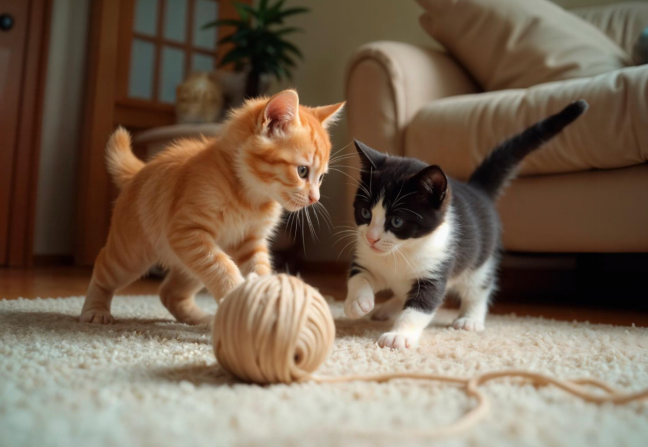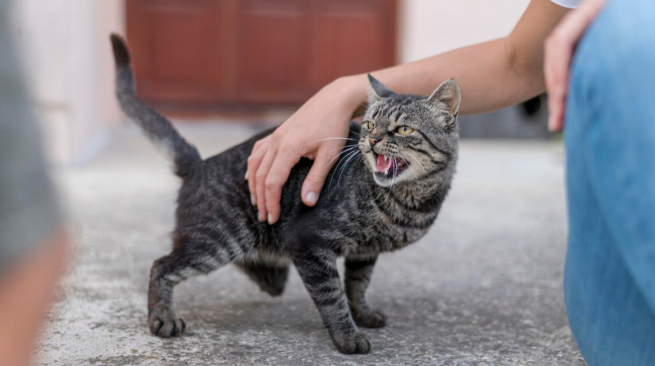Apr 28, 2025
Author:Jackson Watson

Does your pet cat ever stop to listen then bolt forward with its head tilted as if it spotted something peculiar? Cats have been a mystery to human observers since ancient times due to their gentle disposition and elusive signals. Mastering the understanding of these signals brings humans closer to their pet cats. When you study cat habits and behavior, you sharpen your ability to meet their needs and keep them happy.
This guide will walk you through instincts, communication styles, social tips, common hiccups, and health signals. By the end, you’ll feel ready to spot what your cat tries to tell you and respond in ways that build trust and joy between you both.
Cats carry a wild heart even in the coziest living room. Their roots trace back to desert hunters. They still chase, stalk, and pounce on toys or imaginary prey. You may laugh when your cat leaps on a feather wand, but that play fuels an old hunting drive. When you understand cat habits and behavior, you see staging a toy hunt gives them real joy.
Territory matters greatly to cats. They mark spaces by rubbing their cheeks on furniture or scratching posts. Indoors or out, they claim zones where they feel safe. If you deny them marking spots, they might use walls or carpets instead. Giving them vertical and horizontal scratching options lets them honor instinct without ruining your sofa.
Cats guard their survival in subtle ways. They hide in boxes or under beds when they feel stressed. They climb to high perches to get a clear view below. Many cats prowl at twilight or dawn because their ancestors hunted when light dimmed. Satisfying these urges helps them unwind. Place scratching posts near windows or add safe shelves at different heights. Offer feather toys or WOpet automatic feeders to mimic hunting. Meeting these needs keeps your cat calm and curious.
When you honor these instincts, you support both body and mind. Cats with space to climb, scratch, and hunt in play are less likely to act out. You’ll see fewer frayed rugs and more content purring. Learning cat habits and behavior inside and out makes every day smoother for you and your cat.
Cats speak fluently in body signals, sounds, and scent. They ask you to learn their tongue. Start with body language. A straight-up tail means “I feel good.” A tail that twitches or swishes fast warns you they’re irritated. Ears point forward for interest and flatten back for fear or anger. Staring with round pupils can mean they’re hunting or nervous. Slow blinking shows they trust you—try blinking back.
Vocal cues add depth. A single “meow” often means “hello” or “notice me.” A drawn-out meow may demand food or attention. Purring signals comfort, but cats also purr when they feel pain to soothe themselves. Hisses and growls warn you to back off. You’ll learn which meow fits which need by paying close attention.
Scent marking weaves into their talk too. When your cat rubs its face along your leg, it blends its scent with yours. This tells it feels safe with you. Scratching leaves visual marks and scent from glands in their paws. Watching where they choose to scratch tells you what spots feel important.
By watching for these signals, you spy real messages. If you respond by offering space, play, or a gentle pet, your cat learns you listen. As you spot more cues in cat habits and behavior, you step into their world and build trust with every blink and brush.

Cats share unique bonds with people. When your cat bumps its head against your hand, it blends your scent with its own. That act feels like a hug in cat speak. Kneading with their paws shows deep comfort—this behavior hails from kittenhood when they pressed their mother’s belly to nurse. When you pet your cat gently and in the right spot—usually under the chin or behind the ears—you reward them for that trust.
Consistency matters. Cats thrive on routines. Feeding, playtime, and cuddle sessions around the same hours each day give them confidence. When you respect their wake-up naps or play bursts, you show them you know them. Building this routine takes only a few treats and a calm voice each time they greet you.
Multi-cat homes have their own harmony and tension. Cats that groom each other share a strong friendship. They sleep curled together or chase one another in joyful spurts. But cats that stare, flatten ears, or block doorways may feel threatened. Watching their posture helps you step in before a fight.
When introducing a new cat, slow steps pay off. Begin by swapping blankets or bedding so they learn each other’s scent. Offer treats by a closed door, then switch sides. Let them sniff under the door to learn without feeling trapped. Finally, hold short, supervised meetings in a large room with hiding spots on both sides. Praise calm behavior with treats or a soft word.
By guiding introductions and giving each cat its own space to eat, sleep, and perch, you nurture peaceful coexistence. Trust builds over days or weeks. When you understand cat habits and behavior in social settings, you help every cat feel secure and valued.

Cats scratch to shed old claw sheaths, stretch muscles, and mark territory. If they scratch your couch, they seek both paw stretching and scent marking. Offer a sturdy scratching post nearby. Use sisal or cardboard posts that resist wear. Encourage your cat by sprinkling catnip on it or playing with a toy at the base. If they still go for furniture, cover sections with double-sided tape. Cats hate sticky surfaces and will look elsewhere.
If your cat avoids its litter box, look first at cleanliness. Scoop daily and wash the box weekly with mild soap. Place boxes in quiet, low-traffic spots. In a multi-cat home, provide one box per cat plus one extra. Stress can also cause accidents—move the box if a loud appliance scares your cat or add a second box. If problems persist, visit the vet to rule out urinary tract issues.
Some cats meow more than usual when they feel bored, hungry, or lonely. Make sure meal times meet their needs. Offer puzzle feeders to slow down eating and entertain them. Spend time each day playing interactive games. If your cat meows at night, try a late-evening play session to burn energy and a small meal before bed. Ignore meows that seek attention. Cats learn quickly when silence leads to play or petting.
Aggression may stem from rough play, fear, or territory disputes. If play aggression flares, redirect energy to toys. If a stranger spooks your cat, give it space to hide. In tension with other cats, separate them briefly, then reintroduce calmly. If your cat growsl or bites often, consult a behavior specialist or vet. They can rule out pain or fear triggers.
Patience pays off when you apply proactive solutions to these common snags. By tackling issues early, you stay ahead of stress and keep life smooth for both of you. Spotting these patterns in cat habits and behavior helps you respond before problems grow.
Your cat’s actions often whisper clues about its well-being. A cat that suddenly hides may feel pain or stress. If it grooms furiously, itchy skin or allergies might plague it. Overgrooming can leave patches; undergrooming makes coats dull. Changes in appetite—eating more or less—could signal dental troubles, digestive issues, or other health concerns.
By tracking normal patterns, you catch shifts fast. Keep a simple diary of feeding times, play sessions, and litter box visits. Note any odd behavior you notice. When you share specific details with your vet, you speed up diagnosis. Catching problems early makes treatment easier and less stressful for your cat.
Regular vet checkups set a strong baseline for health. Your vet spots subtle signs you might miss. They check weight, teeth, and coat, and test for common illnesses. If you notice anything unusual between visits, don’t wait. Call the clinic and describe changes. You protect your cat by acting on its signals. This habit of observing cat habits and behavior helps you learn and protect your feline friend for years to come.
Cats ask for little beyond food, play, and respect for their space. They give back endless joy when you take the time to learn their ways. By tuning in to instincts, body language, social needs, and health signals, you grow a deep friendship. Remember to watch, respond, and adapt as your cat changes over time. You’ll find that mastering cat habits and behavior leads to a bond you both cherish. Start today, and enjoy every purr, head bump, and playful leap your cat shares with you.
Popular Post

What to Feed a Sick Dog With No Appetite? [2025 Guide]
May 16, 2023

Troubleshooting Common Issues with Automatic Pet Feeders: Tips & Tricks for Pet Owners
Oct 26, 2023

Why Does My Cat Cough After Drinking Water? 8 Potential Reasons
Mar 13, 2023

My Cat Only Eats A Little at A Time - What to Do?
Feb 27, 2023

Why is My Cat Throwing up Water? Top 5 Causes Here
Feb 08, 2023
$99.99
$129.99
Copyright © 2025 WOPET. All Rights Reserved.